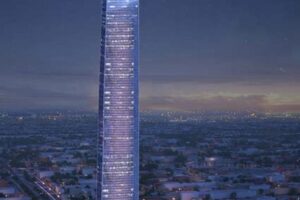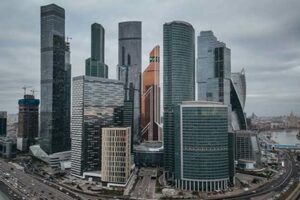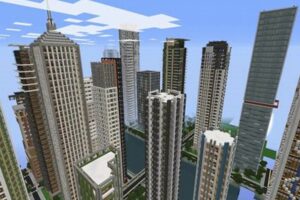Cities without skyscrapers are urban centers that have developed without the presence of high-rise buildings. These cities often have a unique character and charm, with a focus on walkability, historic preservation, and community. Some notable examples of cities without skyscrapers include Venice, Italy; Kyoto, Japan; and Charleston, South Carolina.
There are many benefits to living in a city without skyscrapers. These cities tend to be more livable, with less traffic and pollution. They also have a stronger sense of community, as people are more likely to interact with each other on a daily basis. Additionally, cities without skyscrapers can be more sustainable, as they require less energy to heat and cool.
While cities without skyscrapers may not have the same level of economic development as cities with skyscrapers, they offer a unique and desirable quality of life. These cities are often home to a thriving arts and culture scene, and they attract residents who value community, livability, and sustainability.
1. Walkable
Walkability is a key aspect of cities without skyscrapers. It refers to the ease with which people can walk around a city, and it is influenced by factors such as the width of sidewalks, the presence of pedestrian-friendly crossings, and the overall safety of the streets. Walkable cities are more livable and sustainable, and they encourage people to interact with each other on a daily basis.
In cities without skyscrapers, walkability is often a priority. This is because these cities tend to be more compact and have a human-scale feel. The lack of tall buildings means that there is more space for pedestrians, and the streets are often more inviting. As a result, people are more likely to walk in cities without skyscrapers, which in turn fosters a sense of community and makes these cities more livable.
There are many examples of walkable cities without skyscrapers around the world. Some notable examples include Venice, Italy; Kyoto, Japan; and Charleston, South Carolina. These cities have successfully preserved their historic character while also making them walkable and livable. They are vibrant and thriving communities that offer a unique and enriching experience for residents and visitors alike.
2. Historic
The historic character of cities without skyscrapers is one of their defining features. These cities have often been able to preserve their historic buildings and districts, which gives them a unique charm and character. This historic character is often a major draw for residents and visitors alike, as it provides a sense of connection to the past and a sense of place.
There are many reasons why cities without skyscrapers tend to be more historic. One reason is that these cities have often been able to avoid the pressures of rapid development. Without the need for tall buildings to accommodate a growing population, these cities have been able to preserve their historic buildings and districts. Another reason is that these cities often have a strong sense of community, which has helped to protect their historic character. Residents of these cities value their heritage and are often willing to fight to preserve it.
The historic character of cities without skyscrapers is a valuable asset. It provides these cities with a unique identity and a sense of place. It also attracts residents and visitors alike, who appreciate the opportunity to experience a piece of history. As a result, cities without skyscrapers are often seen as desirable places to live and visit.
3. Charming
The charm of cities without skyscrapers is often attributed to their unique character and sense of place. These cities have often been able to preserve their historic buildings and districts, which gives them a timeless quality. The lack of tall buildings also means that these cities tend to be more walkable and human-scale, which makes them more inviting and charming.
The charm of cities without skyscrapers is also due to their strong sense of community. Residents of these cities often take pride in their city’s unique character and are willing to fight to preserve it. This sense of community is often reflected in the city’s architecture, public spaces, and cultural events. As a result, cities without skyscrapers often have a vibrant and welcoming atmosphere that is attractive to residents and visitors alike.
The charm of cities without skyscrapers is a valuable asset. It provides these cities with a unique identity and a sense of place. It also attracts residents and visitors alike, who appreciate the opportunity to experience a more authentic and charming urban environment. As a result, cities without skyscrapers are often seen as desirable places to live and visit.
4. Community-oriented
Cities without skyscrapers tend to be more community-oriented than cities with skyscrapers. This is due to a number of factors, including the walkability, historic character, and charming atmosphere of these cities. These factors encourage people to interact with each other on a daily basis, which in turn fosters a sense of community.
- Walkability
Walkable cities are more conducive to community interaction. When people can easily walk around their city, they are more likely to encounter their neighbors and strike up conversations. This can lead to a greater sense of community and belonging. - Historic character
Historic cities often have a strong sense of community. This is because historic buildings and districts can serve as a focal point for community gatherings and events. Additionally, historic cities often have a strong sense of place, which can lead to a greater sense of community pride. - Charming atmosphere
Charming cities are often more inviting and welcoming than cities with skyscrapers. This can make people more likely to interact with each other and to feel a sense of community.
The community-oriented nature of cities without skyscrapers is a valuable asset. It provides these cities with a unique identity and a sense of place. It also attracts residents and visitors alike, who appreciate the opportunity to experience a more authentic and charming urban environment. As a result, cities without skyscrapers are often seen as desirable places to live and visit.
5. Sustainable
Cities without skyscrapers are often more sustainable than cities with skyscrapers. This is due to a number of factors, including the walkability, historic character, and community-oriented nature of these cities. These factors contribute to a more sustainable urban environment in the following ways:
- Reduced energy consumption
Cities without skyscrapers tend to be more compact and walkable than cities with skyscrapers. This means that people are more likely to walk, bike, or take public transportation instead of driving. This can lead to significant reductions in energy consumption. - Reduced greenhouse gas emissions
Walking, biking, and taking public transportation produce far fewer greenhouse gas emissions than driving. As a result, cities without skyscrapers tend to have lower greenhouse gas emissions than cities with skyscrapers. - Improved air quality
Fewer cars on the road means less air pollution. Cities without skyscrapers tend to have better air quality than cities with skyscrapers. - More green space
Cities without skyscrapers often have more green space than cities with skyscrapers. This is because there is less need for parking lots and other car-related infrastructure. Green space provides many benefits, including improved air quality, reduced stormwater runoff, and increased biodiversity.
The sustainability of cities without skyscrapers is a valuable asset. It provides these cities with a number of environmental and economic benefits. As a result, cities without skyscrapers are often seen as desirable places to live and visit.
6. Livable
Livable cities are those that are designed to meet the needs of their residents. They are characterized by factors such as walkability, affordability, safety, and a sense of community. Cities without skyscrapers tend to be more livable than cities with skyscrapers for a number of reasons.
First, cities without skyscrapers are often more walkable. This is because they are more compact and have a more human-scale feel. The lack of tall buildings means that there is more space for pedestrians, and the streets are often more inviting. As a result, people are more likely to walk in cities without skyscrapers, which in turn fosters a sense of community and makes these cities more livable.
Second, cities without skyscrapers are often more affordable. This is because there is less demand for land, which means that housing and other costs are lower. As a result, cities without skyscrapers are more affordable for people of all income levels.
Third, cities without skyscrapers are often safer. This is because they tend to have lower crime rates than cities with skyscrapers. This is likely due to a number of factors, including the fact that these cities are more walkable and have a stronger sense of community.
Finally, cities without skyscrapers often have a stronger sense of community. This is because residents of these cities are more likely to interact with each other on a daily basis. This sense of community can make cities more livable and enjoyable for everyone.
In conclusion, cities without skyscrapers are more livable than cities with skyscrapers for a number of reasons. These cities are more walkable, affordable, safe, and have a stronger sense of community. As a result, they are more desirable places to live and visit.
7. Affordable
Affordability is a key component of cities without skyscrapers. This is because the lack of tall buildings means that there is less demand for land, which in turn leads to lower housing costs. As a result, cities without skyscrapers are more affordable for people of all income levels.
There are many examples of affordable cities without skyscrapers around the world. Some notable examples include:
- Havana, Cuba: Havana is a vibrant and historic city with a strong sense of community. The city is home to many affordable housing options, making it a great place to live for people of all income levels.
- Lisbon, Portugal: Lisbon is a beautiful and charming city with a rich history. The city is known for its affordable housing, making it a popular destination for expats and tourists alike.
- Krakow, Poland: Krakow is a historic and cultural city with a thriving arts scene. The city is home to a number of affordable housing options, making it a great place to live for students and young professionals.
The affordability of cities without skyscrapers is a major advantage. It makes these cities more accessible to people of all income levels, which in turn creates a more diverse and vibrant community. Additionally, the affordability of these cities can help to reduce poverty and inequality.
8. Beautiful
Cities without skyscrapers are often considered to be more beautiful than cities with skyscrapers. This is due to a number of factors, including the following:
- Human scale
Cities without skyscrapers are often more human-scale than cities with skyscrapers. This means that the buildings are more in proportion to the people who live in them, and the streets are more walkable. This can create a more intimate and charming atmosphere. - Architectural diversity
Cities without skyscrapers tend to have a more diverse range of architectural styles than cities with skyscrapers. This is because there is less pressure to build tall buildings in order to maximize land use. As a result, cities without skyscrapers can be more visually interesting and stimulating. - Green space
Cities without skyscrapers often have more green space than cities with skyscrapers. This is because there is less need for parking lots and other car-related infrastructure. Green space can make a city more beautiful and livable, and it can also provide a number of environmental benefits. - Skyline
The skyline of a city without skyscrapers is often more varied and interesting than the skyline of a city with skyscrapers. This is because there are no tall buildings to block the view of the sky and the surrounding landscape.
In conclusion, there are a number of reasons why cities without skyscrapers are often considered to be more beautiful than cities with skyscrapers. These factors include the human scale, architectural diversity, green space, and skyline of these cities.
9. Unique
Cities without skyscrapers are unique in a number of ways. First, they tend to have a more human scale than cities with skyscrapers. This means that the buildings are more in proportion to the people who live in them, and the streets are more walka
ble. This can create a more intimate and charming atmosphere.
Second, cities without skyscrapers often have a more diverse range of architectural styles than cities with skyscrapers. This is because there is less pressure to build tall buildings in order to maximize land use. As a result, cities without skyscrapers can be more visually interesting and stimulating.
Third, cities without skyscrapers often have more green space than cities with skyscrapers. This is because there is less need for parking lots and other car-related infrastructure. Green space can make a city more beautiful and livable, and it can also provide a number of environmental benefits.
Finally, the skyline of a city without skyscrapers is often more varied and interesting than the skyline of a city with skyscrapers. This is because there are no tall buildings to block the view of the sky and the surrounding landscape.
The uniqueness of cities without skyscrapers is a valuable asset. It makes these cities more attractive to residents and visitors alike. It also helps to create a more sustainable and livable environment.
FAQs
This section addresses some frequently asked questions and misconceptions about cities without skyscrapers. Read on to learn more about the unique characteristics and advantages of these cities.
Question 1: Are cities without skyscrapers less developed than cities with skyscrapers?
Not necessarily. While cities with skyscrapers may have a more modern appearance, the presence or absence of skyscrapers is not an accurate indicator of a city’s level of development. Cities without skyscrapers can be just as developed as cities with skyscrapers, offering a high quality of life, advanced infrastructure, and a thriving economy.
Question 2: Are cities without skyscrapers more boring than cities with skyscrapers?
On the contrary, cities without skyscrapers often have a unique charm and character that can be lacking in cities with skyscrapers. The absence of tall buildings allows for more open spaces, historic architecture, and a more intimate urban experience. Many cities without skyscrapers are known for their vibrant arts and culture scenes, offering a rich variety of entertainment and cultural attractions.
Question 3: Are cities without skyscrapers less convenient than cities with skyscrapers?
Not necessarily. While cities with skyscrapers may have certain advantages related to vertical transportation and office space, cities without skyscrapers can be just as convenient for residents and visitors. Many cities without skyscrapers have well-developed public transportation systems, making it easy to get around without a car. Additionally, the compact nature of these cities often means that essential amenities and services are within easy walking distance.
Question 4: Are cities without skyscrapers less safe than cities with skyscrapers?
There is no clear correlation between the presence or absence of skyscrapers and crime rates. In fact, some studies have shown that cities without skyscrapers can be safer than cities with skyscrapers. The walkable, community-oriented nature of these cities can foster a sense of safety and security among residents.
Question 5: Are cities without skyscrapers less modern than cities with skyscrapers?
Modernity is not solely defined by the presence of skyscrapers. Cities without skyscrapers can be just as modern as cities with skyscrapers in terms of infrastructure, technology, and innovation. These cities often embrace sustainable urban planning practices and invest in renewable energy sources, making them leaders in environmental consciousness.
Question 6: Why should I consider living in a city without skyscrapers?
Cities without skyscrapers offer a unique and desirable lifestyle that appeals to a diverse range of people. These cities provide a more human-scale environment, with a focus on walkability, community, and sustainability. They offer a rich cultural experience, affordable housing options, and a higher quality of life. Whether you are seeking a more authentic urban experience, a healthier lifestyle, or a stronger sense of community, cities without skyscrapers are worth exploring.
Summary: Cities without skyscrapers offer a distinct and rewarding urban experience. They are not less developed, boring, inconvenient, unsafe, or outdated compared to cities with skyscrapers. Rather, they provide a unique blend of charm, livability, and sustainability that appeals to those seeking a more human-scale and community-oriented lifestyle.
Next: Explore the architectural marvels of cities without skyscrapers, where historic preservation meets modern innovation.
Tips for Thriving in Cities Without Skyscrapers
Cities without skyscrapers offer a unique and rewarding urban experience. Embracing the distinct character of these cities can enhance your enjoyment and well-being. Here are some tips to help you thrive in a city without skyscrapers:
Embrace the walkability: Take advantage of the walkable nature of these cities. Explore your neighborhood on foot, discovering hidden gems and fostering a sense of community. The lack of tall buildings creates a more pedestrian-friendly environment, allowing you to appreciate the city’s architecture and street life.
Engage with the community: Cities without skyscrapers often have a strong sense of community. Participate in local events, join community groups, and support local businesses. The close-knit nature of these cities provides opportunities to build meaningful connections and contribute to the neighborhood’s well-being.
Explore the historic charm: Many cities without skyscrapers have preserved their historic character. Take time to appreciate the historic buildings, landmarks, and cultural heritage. Engage with local history through museums, walking tours, and conversations with long-time residents. Preserving and celebrating the past enriches the present and future of the city.
Support local businesses: Cities without skyscrapers often rely on small, locally owned businesses. Patronize these businesses to contribute to the local economy and maintain the unique character of the city. From independent bookstores to cozy cafes and artisan shops, local businesses add charm and diversity to the urban landscape.
Embrace sustainability: Cities without skyscrapers often prioritize sustainability due to their compact nature. Utilize public transportation, walk, or bike to reduce your carbon footprint. Support initiatives that promote renewable energy, waste reduction, and green spaces. By embracing sustainability, you contribute to the long-term health and livability of the city.
Summary: By embracing the walkability, community spirit, historic charm, local businesses, and sustainability efforts, you can fully experience the unique of cities without skyscrapers. These cities offer a more human-scale, livable, and fulfilling urban environment that fosters a strong sense of place and well-being.
Next: Discover the hidden architectural gems and innovative urban planning strategies that make cities without skyscrapers stand out.
Conclusion
Cities without skyscrapers offer a unique and rewarding urban experience that stands apart from the towering metropolises of the world. Throughout this exploration, we have delved into the defining characteristics of these cities, including their walkability, affordability, community-oriented nature, sustainability, beauty, and architectural diversity.
Embracing the distinct character of cities without skyscrapers allows for a more fulfilling and human-scale urban lifestyle. By prioritizing walkability, engaging with the
community, exploring historic charm, supporting local businesses, and embracing sustainability, residents can contribute to the well-being and prosperity of these cities.
As the world continues to grapple with urbanization and its challenges, cities without skyscrapers provide valuable lessons in sustainable urban planning and community building. They offer an alternative model of urban living that emphasizes livability, human connection, and environmental consciousness. By recognizing and celebrating the unique qualities of cities without skyscrapers, we can inspire more inclusive, sustainable, and vibrant urban centers for the future.







